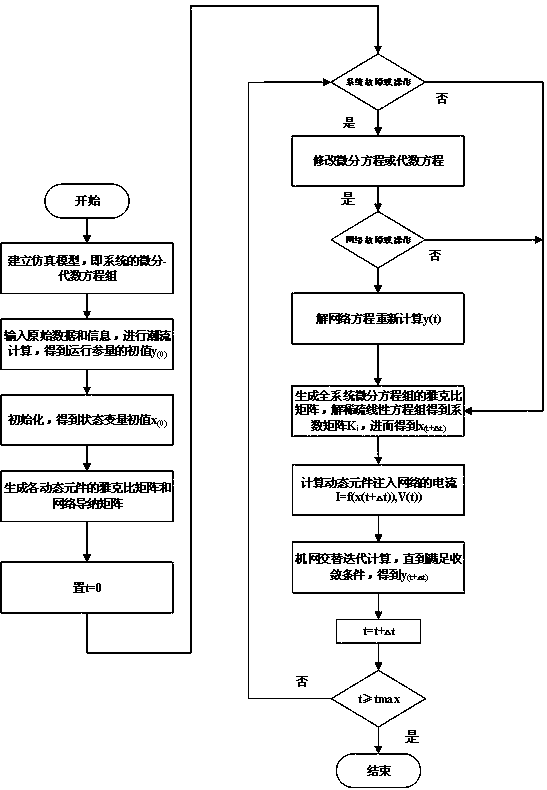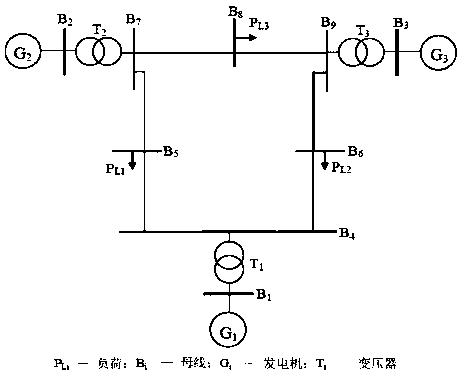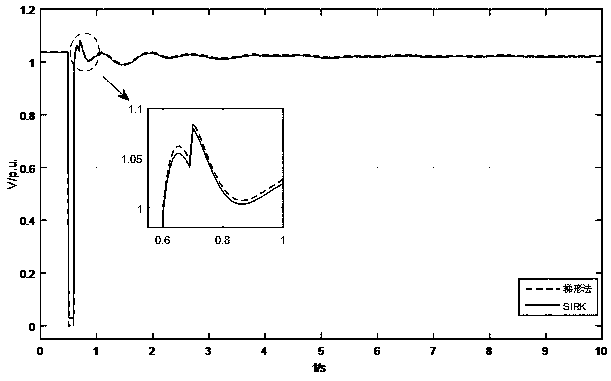Electric power system transient stability calculation method based on semi-implicit Runge-Kutta method
A Runge-Kutta method and power system technology, which is applied in the field of transient stability calculation of power systems based on semi-implicit Runge-Kutta method, which can solve the problems of difficult transient stability simulation of rigid systems, poor numerical stability, and computational speed. Slow and other problems, to achieve the effect of efficient, accurate and stable calculation, good numerical stability, and fast calculation efficiency
- Summary
- Abstract
- Description
- Claims
- Application Information
AI Technical Summary
Problems solved by technology
Method used
Image
Examples
Embodiment 1
[0052] Power system transient stability calculation method based on semi-implicit Runge-Kutta method, such as figure 1 Shown:
[0053] S1. Establish dynamic component models required for power system transient stability simulation calculation, including generator model, exciter model, PSS model, prime mover model, load model, etc.;
[0054] The system differential equations and algebraic equations are formed to form the whole system dynamic simulation mathematical model, which is described by the differential algebraic equations shown in the following formula:
[0055]
[0056] Among them, x is the state variable describing the characteristics of the dynamic element, and y is the operating parameter of the system in the algebraic equations;
[0057] S2, input raw data and information, perform power flow calculation, and obtain the initial value y of the operating parameter before the system is disturbed (0) , Including the voltage of each node of the system And the power injected int...
Embodiment 2
[0089] Take the 3-machine 9-node power system as an example, the single-line structure diagram is as follows figure 2 As shown, there are 3 generators, 3 loads, and 9 branches in the system. The generator adopts the classic second-order model, the load is simulated by constant impedance, the power network is described by the admittance matrix, and the differential equation is described by the second-order three The first-order semi-implicit Runge-Kutta method is used to solve the network equations using the direct method. The entire transient stability calculation process using the above model is as follows:
[0090] Establish a dynamic model to form a system of differential-algebraic equations. The dynamic element model in the system is only a generator, and its classic second-order generator model is
[0091]
[0092] Where T J Is the rotor moment of inertia, D is the damping coefficient
[0093] The system of differential-algebraic equations is as follows:
[0094]
[0095] Among...
PUM
 Login to View More
Login to View More Abstract
Description
Claims
Application Information
 Login to View More
Login to View More - R&D
- Intellectual Property
- Life Sciences
- Materials
- Tech Scout
- Unparalleled Data Quality
- Higher Quality Content
- 60% Fewer Hallucinations
Browse by: Latest US Patents, China's latest patents, Technical Efficacy Thesaurus, Application Domain, Technology Topic, Popular Technical Reports.
© 2025 PatSnap. All rights reserved.Legal|Privacy policy|Modern Slavery Act Transparency Statement|Sitemap|About US| Contact US: help@patsnap.com



